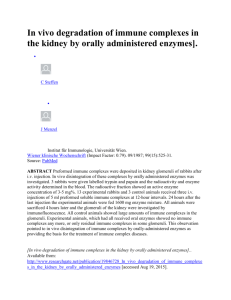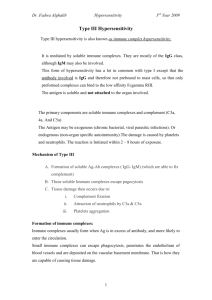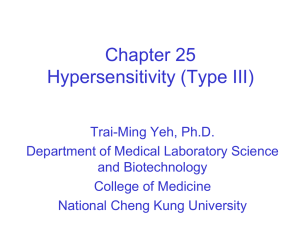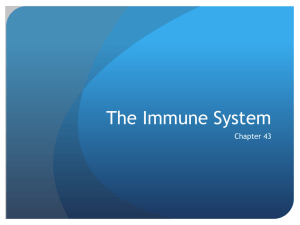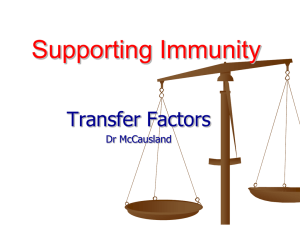immune complex-mediated (type iii) hypersensitivity - U
advertisement
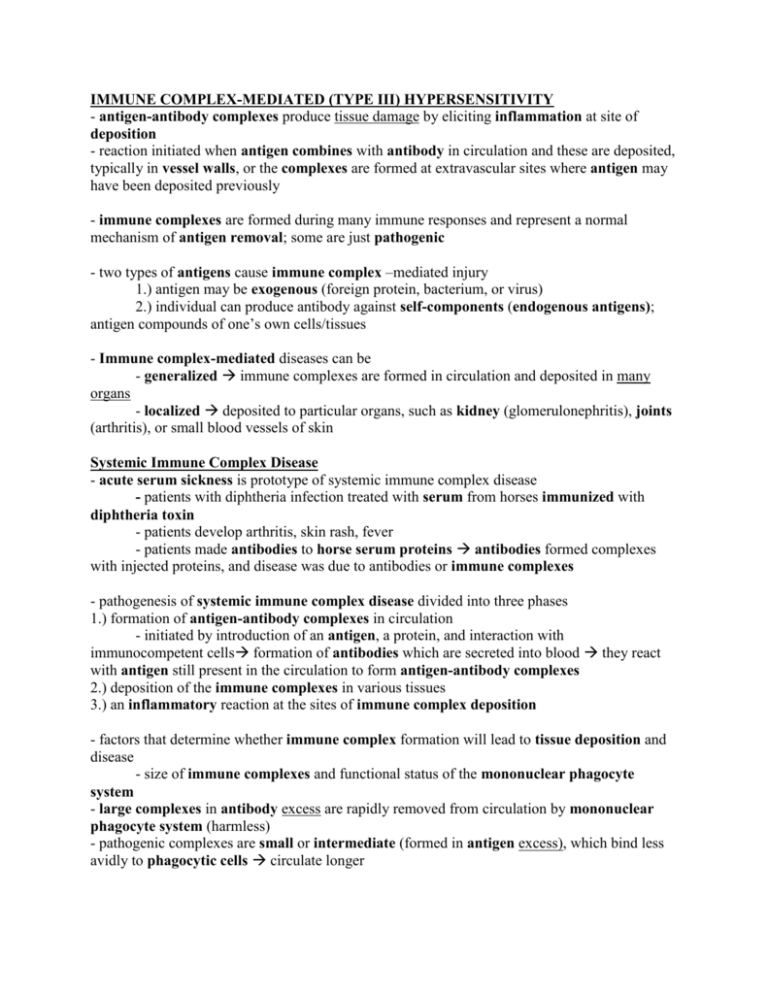
IMMUNE COMPLEX-MEDIATED (TYPE III) HYPERSENSITIVITY - antigen-antibody complexes produce tissue damage by eliciting inflammation at site of deposition - reaction initiated when antigen combines with antibody in circulation and these are deposited, typically in vessel walls, or the complexes are formed at extravascular sites where antigen may have been deposited previously - immune complexes are formed during many immune responses and represent a normal mechanism of antigen removal; some are just pathogenic - two types of antigens cause immune complex –mediated injury 1.) antigen may be exogenous (foreign protein, bacterium, or virus) 2.) individual can produce antibody against self-components (endogenous antigens); antigen compounds of one’s own cells/tissues - Immune complex-mediated diseases can be - generalized immune complexes are formed in circulation and deposited in many organs - localized deposited to particular organs, such as kidney (glomerulonephritis), joints (arthritis), or small blood vessels of skin Systemic Immune Complex Disease - acute serum sickness is prototype of systemic immune complex disease - patients with diphtheria infection treated with serum from horses immunized with diphtheria toxin - patients develop arthritis, skin rash, fever - patients made antibodies to horse serum proteins antibodies formed complexes with injected proteins, and disease was due to antibodies or immune complexes - pathogenesis of systemic immune complex disease divided into three phases 1.) formation of antigen-antibody complexes in circulation - initiated by introduction of an antigen, a protein, and interaction with immunocompetent cells formation of antibodies which are secreted into blood they react with antigen still present in the circulation to form antigen-antibody complexes 2.) deposition of the immune complexes in various tissues 3.) an inflammatory reaction at the sites of immune complex deposition - factors that determine whether immune complex formation will lead to tissue deposition and disease - size of immune complexes and functional status of the mononuclear phagocyte system - large complexes in antibody excess are rapidly removed from circulation by mononuclear phagocyte system (harmless) - pathogenic complexes are small or intermediate (formed in antigen excess), which bind less avidly to phagocytic cells circulate longer - overload or dysfunction of mononuclear phagocyte system increases change of persistence of immune complexes in circulation and tissue deposition - favored sites of immune complex deposition are renal glomeruli, skin, joints, heart, serosal surfaces, and small blood vessels - deposition in vessel wall requires increase in vascular permeability; this occurs when immune complexes bind to inflammatory cells through Fc or C3b receptors and trigger release of vasoactive mediators and permeability-enhancing cytokines (mast cell involvement) - third acute inflammatory phase fever, urticaria (itching wheals), arthralgias (joint pain), lymph node enlargement, and proteinuria - two mechanisms believe to cause inflammation at site of deposition 1.) activation of complement cascade - promotes inflammation by production of chemotactic factors, which direct migration of neutrophils (C5a) and monocytes and by release of anaphylatoxins (C3a and C5a cause histamine release) which increase vascular permeability 2.) activation of neutrophils and macrophages through their Fc receptors - leukocytes that a drawn in by chemotactic factors are activated by engagement of their C3b and Fc receptors by immune complexes results in production of pro-inflammatory substances, including prostaglandins, vasodilator peptides, and chemotactic substances, and lysosomal enzymes (proteases that digest basement membrane, collage, elastin, and cartilage) - tissue damage is also mediated by oxygen free radicals produced by activated neutrophils - immune complexes have several other effects, including aggregation of platelets (platelet activating factor, PAF) and activation of Hageman factor (XII, causes activation of kinin system vasodilation, edema) both of these reactions augment the inflammatory process and initiate formation of microthrombi ischemia, necrosis and vasculitis if it occurs in blood vessels; glomerulonephritis if it occurs in renal glomeruli; arthritis in joints - important role of complement in tissue injury during active phase of disease consumption of complement decreases serum levels - fibrinoid necrosis acute necrotizing vasculitis; necrosis of vessel wall and neutrophilic infiltration; necrotic tissue and deposits of immune complexes, complement, and plasma protein produce a eosinophilic deposit that obscures the underlying cellular detail (fibrinoid necrosis) - chronic form of serum sickness results from repeated or prolonged exposure to an antigen; systemic lupus erythematosus (SLE) associated with persistent antibody responses to autoantigens Local Immune Complex Disease (Arthus Reaction) - the Arthus reaction is a localized area of tissue necrosis resulting from acute complex vasculitis (in skin) - intracutaneous injection of antigen in an immune animal having circulating antibodies against antigen - as antigen diffuses into vascular wall, it binds the pre-formed antibody, and large immune complexes are formed which precipitate in the vessel walls and trigger inflammatory reaction - Igs and fibrinogen deposited in vessel walls, usually venules, and the vessels show fibrinoid necrosis and inflammation - thrombi are formed in the vessels local ischemic injury CELL –MEDIATED (TYPE IV) HYPERSENSITIVITY - cell-mediated hypersensitivity initiated by antigen-activated T lymphocytes - delayed type mediated by CD4+ T cells and direct cell cytotoxicity mediated by CD8+ T cells - response to mycobacterium Tb, viruses, fungi protozoa, and parasite; autoimmune diseases Delayed Type Hypersensitivity - tuberculin reaction in previously sensitized individual redness and induration (firmness) - delayed type hypersensitivity perivascular cuffing around small veins/venules - increased microvascular permeability; plasma proteins escape edema, deposition of fibrin - nondegradable antigens (tubercle bacillus in lung) initial perivascular lymphocytic infiltrate replaced by macrophages epitheliod cells surrounded by lymphocytes (granuloma) - when individual first exposed to protein antigens of tubercle bacilli, naïve CD4+ T cells recognize peptides derived form antigens in association with MHC class II on APC differentiation of naïve CD4+ T cells to TH1 cells (secretes cytokines) - intracutaneous injection of tuberculin in previously exposed individual to tubercle bacilli, memory TH1 cells recognize antigen displayed by APC and are activated - TH1 cells secrete cytokines, IFN- responsible for expression of delayed-type hypersensitivity - Il-12 from macrophages, dendritic cells (APCs); initial encounter with microbe APCs presenting microbial antigen secrete IL-12 (CD4+ to TH1); IL-12 induces IFN- secretion by T cells and NK cells; IFN- further augments differentiation of TH1 cells - IFN- activates macrophages to phagocytose/kill microorganisms; more class II MHC on surface; PDGF fibroblast proliferation; TNF, IL-1 secretion for inflammation; produce more IL-12 - IL-2 autocrine/paracrine proliferation of T cells - TNF increases secretion of prostacyclin (increased blood flow causing vasodilation), increased expression of adhesion molecules that promote attachment of passing lymphocytes and monocytes, and chemokine induction (IL-8) - these changes cause extravasation of lymphocytes and monocytes at site of delayed hypersensitivity reaction - chemokines produced by T cells and macros recruit more leukocytes in reaction site T Cell-mediated cytotoxicity - sensitized CD8+ T cells kill antigen-bearing target cells; cells called cytotoxic T lymphocytes (CTLs); tissue destruction - in a virus-infected cell, viral peptides associated with MHC class I are transported to surface and recognized by TCR of cytotoxic CD8+ T lymphocytes - lysis of infected cells leads to elimination of infection - T-cell mediated damage - perforin-granzyme-dependent killing - Fas-Fas ligand-dependent killing - perforins/granzymes contained in lysosome-like granules of CTLs - perforin perforates plasma membranes of target cells that under attack by CD8+ lymphocytes - at first, CD8+ T cells come in close contact with target cells, followed by polymerization of the released perforin molecules and their insertion into the target cell membranes - CTL granules contain granzymes (proteases) which are delivered into target cells; they activate caspases induce apoptosis of target cells - perforin pores allow water to enter cells osmotic lysis - Fas-dependent killing also induces apoptosis of the target cells; Fas ligand binds to Fas on target cells

